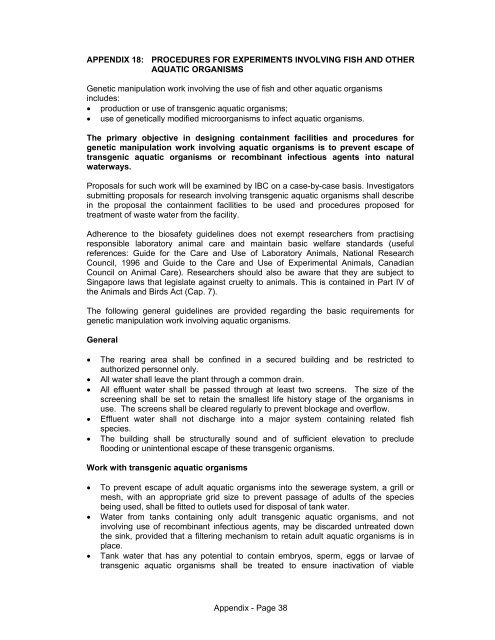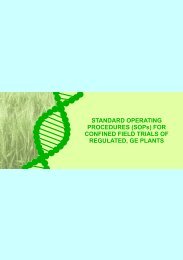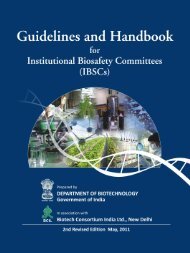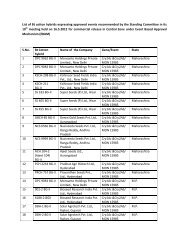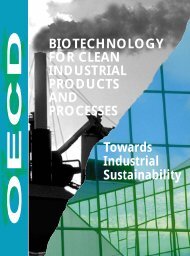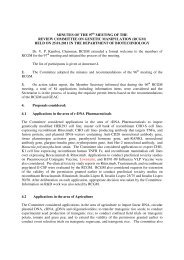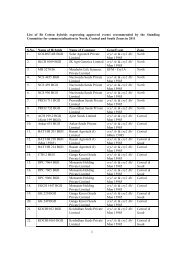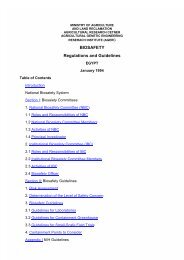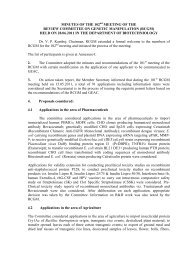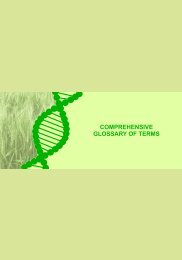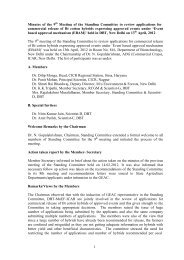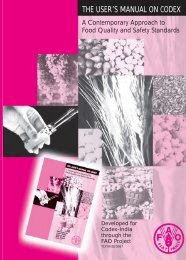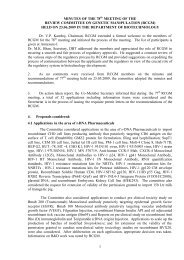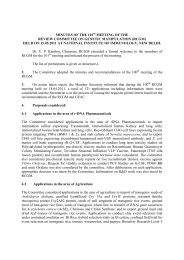Biosafety Guidelines For Research On Genetically Modified ...
Biosafety Guidelines For Research On Genetically Modified ...
Biosafety Guidelines For Research On Genetically Modified ...
Create successful ePaper yourself
Turn your PDF publications into a flip-book with our unique Google optimized e-Paper software.
APPENDIX 18: PROCEDURES FOR EXPERIMENTS INVOLVING FISH AND OTHER<br />
AQUATIC ORGANISMS<br />
Genetic manipulation work involving the use of fish and other aquatic organisms<br />
includes:<br />
• production or use of transgenic aquatic organisms;<br />
• use of genetically modified microorganisms to infect aquatic organisms.<br />
The primary objective in designing containment facilities and procedures for<br />
genetic manipulation work involving aquatic organisms is to prevent escape of<br />
transgenic aquatic organisms or recombinant infectious agents into natural<br />
waterways.<br />
Proposals for such work will be examined by IBC on a case-by-case basis. Investigators<br />
submitting proposals for research involving transgenic aquatic organisms shall describe<br />
in the proposal the containment facilities to be used and procedures proposed for<br />
treatment of waste water from the facility.<br />
Adherence to the biosafety guidelines does not exempt researchers from practising<br />
responsible laboratory animal care and maintain basic welfare standards (useful<br />
references: Guide for the Care and Use of Laboratory Animals, National <strong>Research</strong><br />
Council, 1996 and Guide to the Care and Use of Experimental Animals, Canadian<br />
Council on Animal Care). <strong>Research</strong>ers should also be aware that they are subject to<br />
Singapore laws that legislate against cruelty to animals. This is contained in Part IV of<br />
the Animals and Birds Act (Cap. 7).<br />
The following general guidelines are provided regarding the basic requirements for<br />
genetic manipulation work involving aquatic organisms.<br />
General<br />
• The rearing area shall be confined in a secured building and be restricted to<br />
authorized personnel only.<br />
• All water shall leave the plant through a common drain.<br />
• All effluent water shall be passed through at least two screens. The size of the<br />
screening shall be set to retain the smallest life history stage of the organisms in<br />
use. The screens shall be cleared regularly to prevent blockage and overflow.<br />
• Effluent water shall not discharge into a major system containing related fish<br />
species.<br />
• The building shall be structurally sound and of sufficient elevation to preclude<br />
flooding or unintentional escape of these transgenic organisms.<br />
Work with transgenic aquatic organisms<br />
• To prevent escape of adult aquatic organisms into the sewerage system, a grill or<br />
mesh, with an appropriate grid size to prevent passage of adults of the species<br />
being used, shall be fitted to outlets used for disposal of tank water.<br />
• Water from tanks containing only adult transgenic aquatic organisms, and not<br />
involving use of recombinant infectious agents, may be discarded untreated down<br />
the sink, provided that a filtering mechanism to retain adult aquatic organisms is in<br />
place.<br />
• Tank water that has any potential to contain embryos, sperm, eggs or larvae of<br />
transgenic aquatic organisms shall be treated to ensure inactivation of viable<br />
Appendix - Page 38


